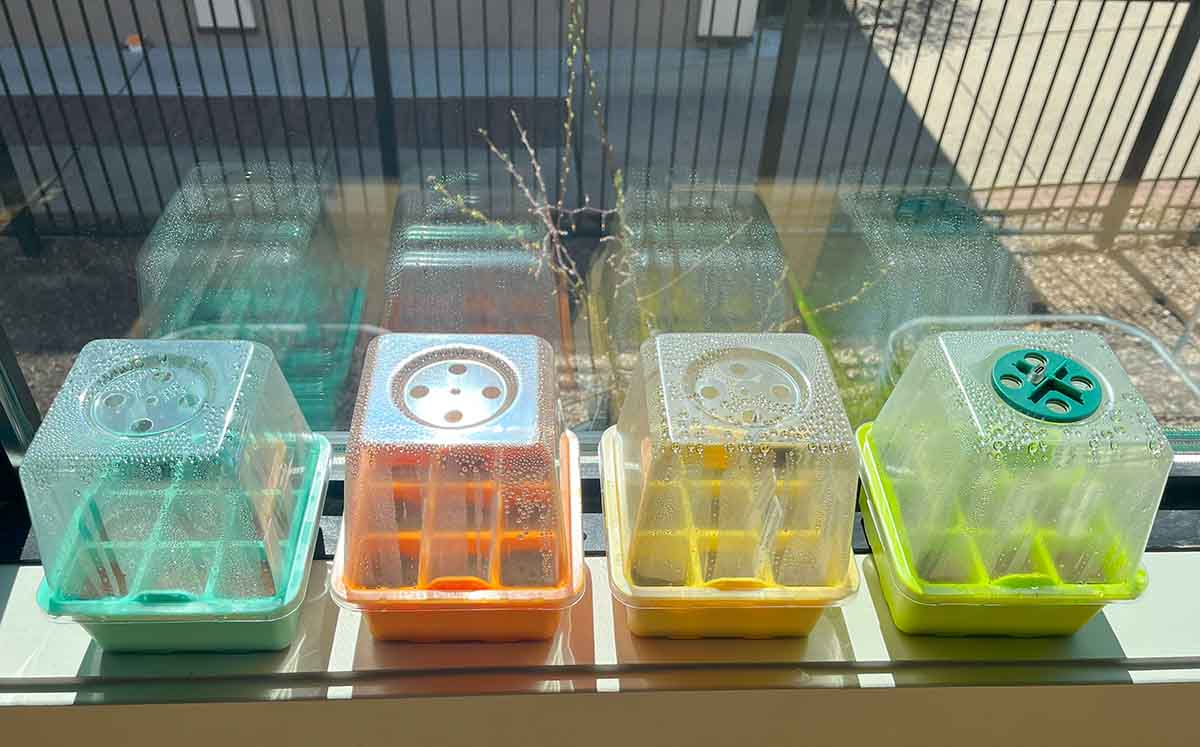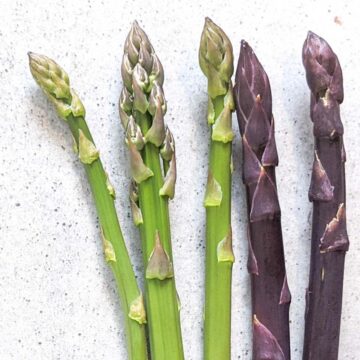I finally bought reusable seed starting trays to replace the flimsy black plastic ones that crack apart after a single season. The new seed starting trays are silicon, can be sanitized in the dishwasher, and come with humidity domes and built in mini grow lights.

The cost is pretty affordable as well, coming out to about $0.50 cents per plant. I plan to use these for the next 10 years or more, which means they would come out to about $0.05 cents instead!
Jump to:
My current seed starting setup
I bought these colorful silicon seed starting trays this year - both for fun and function. They sit adorably in the window, making me smile every time I walk by. As a bonus - they are as practical as they are cute.

Why use silicon seed starting trays
Silicon seed starting trays have recently started popping up and are gaining popularity over the standard paper-thin black plastic trays you find at nurseries. Those plastic trays crack after one use and can get a bit toasty on a seedling heat mat.
The silicon trays are flexible, making it easy to push on the bottom to pop the plant out for transplanting. They can also be placed in the dishwasher for easy sanitizing year after year.

Why these trays
After browsing through all of the silicon seed starting tray options on Amazon and nursery websites, I settled on these trays from Amazon. I think you get a lot for the price and the quality is high.
I bought the 8-pack of silicon trays that each come with a thick plastic bottom, and a tall 4" humidity dome with mini grow lights built in. It also comes with 80 plant tags and a couple mini plastic tools for punching holes in soil or scooping soil. Each tray has 9 cells for a total of 72 cells.

Product details
I took measurements of the seed starting trays in case you are trying to fit them on a windowsill, a standard tray size, or trying to determine what to use for your seed starting medium.
- Silicon tray is exactly 5" x 5"
- Cell interior is 1.5" x 1.5"
- Silicon tray height: 2.25"
- Plastic tray: 5.75" x 5.75" to edge of lip, and 4.75" x 4.75" across the bottom
- Plastic tray height: 2.75"
- Dome: 4" high
- USB cable to power grow lights: 14" long
The 8-pack of silicon trays comes with 4 USB "double" cables to power the grow lights. Each cable splits into 2 cords and each of those cords is 14" long. I bought a $15 USB power strip to plug them in.
Everything you need for seed starting is listed at the bottom of this post, in one place.

Seed starting mixes
In my experience, the most important factor for successful seed starting is finding the right soil or growing medium. This can make germination easy or near impossible, depending on what you choose. The two easiest seed starting options are Horticubes and OrganiPlugs. Seed starting soil mixes are also a good option.
Seeds need to stay moist in order to germinate. It might seem like you can simply pick any soil and keep it watered, but too much water without drying out invites mold. Mold can stunt or kill the seedlings.
Seed starting soil mixes are formulated to hold moisture, often including perlite or peat, which is a good thing! But I've found soil to be too finicky for seed germination for my liking. It seems too easy to underwater, resulting in poor germination, but overwatering often leads to mold growth on the top. I know other people who have had more luck with soil mixes or soil blocking.

This year I'm trying out OrganiPlugs and they've worked out well so far. They are made of peat and coco coir and feel quite spongy. They stay moist and so far I haven't run into mold problems (and don't expect to).
OrganiPlugs are made to fit into standard seed starting trays. They fit almost perfectly in each cell of the silicon trays I bought - they have just a little bit of wiggle room.
I'm also using Horticubes for herbs this year. They don't fit in the silicon trays, instead they are meant to sit in a large tray then get transplanted shortly after germination.
(All of the products are also listed at the bottom of this post in one place).
Alternative seed starting options
I have a couple other options to suggest if for some reason you don't want to share in the joy of these cute, resusable trays!
Upcycle disposable containers
Empty yogurt, fruit cup, or applesauce containers make great seed starting pots - just be sure to drill a few holes in the bottom. Leftover take-out containers work well as a tray to collect the draining water.
When upcycling containers, you'll likely need to use a seed starting soil mix. If you do this, be sure to check the moisture levels several times a day so it doesn't dry out, or stay too wet.
OrganiPlug pre-filled tray
OrganiPlug offers a 50-cell tray pre-filled with their OrganiPlugs. It doesn't get much easier than that. However, the tray will likely only be usable for 1-2 years as the thin plastic will crack as you remove the plants for transplanting.
Oasis Horticubes
I actually use this seed starting method every year, including this year - Horticubes. They are the most reliable and easiest seed germinating medium. I really can't stress how easy these are to use.
These feel like foam but are made from biodegradable materials that will continuously break down over the course of the year. It's sterile medium so it won't transfer pests or diseases.
Horticubes hold water extremely well and don't mold. Seed germination is easy and all but guaranteed. I never run into problems when using Horticubes.
The downside is they are very small and offer no nutrients. That's fine for germination but they will need to be transplanted to larger containers as soon as their first set to true leaves shows up. If you don't transplant, they just stop growing (I know, because I've done it!)
I use these every year for starting herb seeds where I want a bunch of each type of plant. Once they sprout, I transplant them to a larger tray with soil that I continue to water. When they are ready to be transplanted outdoors, I break apart the roots if they've grown together and set them in their sunny spots!
One note worth mentioning is the sheets that arrive are fragile. They can easily break apart if you aren't careful or if shipping was rough.
Get Horticubes on Amazon or Harris Seeds for a similar price.
Other options
There are a few other options to consider - rockwool, foam plugs, and seed starting soil mixes. I don't think these options are as good as the ones listed above, however.
Rockwool is made from molten rock that is spun into threads to create the product. I used rockwool cubes a while back but stopped when I learned it might be harmful to the lungs.
It's too bad because they are a fantastic medium. They are relatively cheap ($0.10 per cube or less), hold water extremely well, and never mold. Seed germination in these is outstanding.
Some people still use them, and I don't feel like I've found enough credible evidence to confidently advise against using these. I personally don't use them because I prefer to err on the side of caution, and I've found other alternatives.
Foam plugs are another option. They actually work quite well - they hold water, don't mold, and are affordable. But I personally don't use them because they don't compost into the soil, leaving little spongy plugs around.
Seed starting soils are formulated specifically for seed starting. They often contain perlite, peat, and coco coir to hold water. As I mentioned earlier though, I always have trouble with either over watering and getting mold problems, or underwatering, resulting in poor germination.
If you've had luck with seed starting soils in the past, then I see no reason you wouldn't continue to have success. It's a good, affordable option!
Where to buy
Amazon is actually a great place for seed starting supplies. I find their prices are often much lower than online seed websites and even hardware stores. The links in this article are affiliate links, which means I get a small commission if you make a purchase (and a big thanks if you do!). In return, I only recommend products that I personally use and feel good recommending.
Everything you need for seed starting with my silicon tray setup:
Alternatives
- OrganiPlug pre-filled tray
- Horticubes (larger) - these are the ones I use
- Horticubes (smaller)
- Black plastic 6-cell nursery packs (thin plastic, 1-2 uses)
- Plastic plant labels: 100 count or 300 count for a couple dollars more
Extras:
Seeds need warmth to germinate, so most people set them on a little heat mat. Once they germinate, remove them from the heat mat and leave them at room temperature.
The heat mats get slightly warmer than room temperature, and the inexpensive ones don't have controls other than being plugged in or not. Mine are all like this and were very inexpensive (small ones are around $15). This 10x20" heat mat will fit the 8 silicon trays (they might hang off the edges a little). I don't have this one in particular because I bought mine over 10 years ago. It has good reviews and looks exactly the same as what I use.
Alternatively, set your seeds on top of your fridge to germinate. It's just warm enough to lend a helping hand instead of a heat mat.

Where to buy seeds
I bought seeds from a dozen vendors last year. In part it was to evaluate vendors since so many people ask me for my favorite sources. But part of it was chasing unique varieties that only one or two vendors sold.
I share a dozen of the best places to buy seeds, from incredibly cheap sources for $2 or less, to fully organic but more expensive. I also have a good source that specializes in each specific climate, including the Pacific Northwest, West Coast, Southwest, Southeast, Midwest, and Northeast.
For information on how to start your seeds, Swanson Nursery has a good tutorial.

Store your seeds in a binder
4-pocket binder sheets fit seed packets perfectly. The smallest pack you can buy seems to be 25-30, which gives you 100-120 pockets. When storing them back-to-back (one faces front, one faces back), you get double the storage for 200-240 seed packets. I bought a 50-pack and it was way too many - oops.
I also bought a 1.5" thick binder which was definitely too small. I would definitely recommend a 3" ring binder, especially if you are storing large seeds like beans, peas, and corn.
You might also like
I've been gardening for almost 2 decades across the country in several different climates. I've been writing detailed guides to answer your questions, from where to buy seeds to how the heck does asparagus actually grow?





Leave a Reply